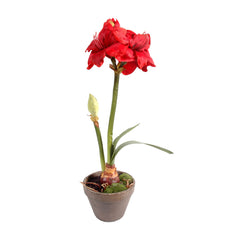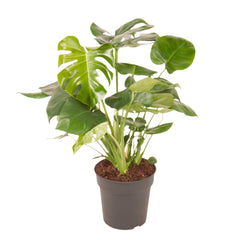dangerous plants
for your cat and pets
for your cat and pets
They are aesthetic, they clean up the air and they make us feel less alone. We love them for their varied colors, amazing growth, and sometimes even their floral smell. Being surrounded by plants definitely lifts the spirits for many of us. Apparently, we're not the only ones who love them so much. Our furry friends, especially those tanning cats, love it just as much! The question that persists: How can these two precious friends live together without one harming the other?
This is a subject that our customers often ask about at Jardin des Animaux, so we want to guide you further in solving this ugly problem.
- Your cat thinks he's the king of your jungle and nibbles on your plants?
- Are you worried that one of your plants is harmful to your animal?
- Not sure what kind of plants to shop while considering your furry friend?
- Is your cat attracted to the soil in your plant pots?
Do not look any further. We've got some solutions for you, including a comprehensive list of plants to watch out for, ideas for safer locations for your plants, and tips and tricks for redirecting your cat's snacking to healthier options.

Be extra careful with these poisonous plants
First, it is important to specify that no official scientific study has been carried out to evaluate the toxicity of houseplants on our pets. The lists we see on the web are actually based on the most frequently encountered reactions. Therefore, you should not immediately take into account that a plant is 100% safe since your pet may not tolerate it despite everything. We therefore suggest taking all your precautions with all types of plants. To help you, here is a non-exhaustive list of plants not to be made available to our pets:
 -Croton
-Croton
 -Dieffenbachia
-Dieffenbachia
 -Cycas
-Cycas
 -Amaryllis
-Amaryllis
 - Oleander (very toxic!)
- Oleander (very toxic!)
 -Ficus
-Ficus
 -Fox tail
-Fox tail
 -Misery
-Misery
 -Aglaonema
-Aglaonema
 -Ivy
-Ivy
 -Euphorbia
-Euphorbia
 -Philodendrons
-Philodendrons
 -Pothos
-Pothos
 -Monstera Deliciosa
-Monstera Deliciosa
 -Peace lily (very poisonous!)
-Peace lily (very poisonous!)
 -Elephant Ear
-Elephant Ear
 -Clivia
-Clivia
 -Anthurium
-Anthurium
 -Bridle
-Bridle
 -Poinsettia
-Poinsettia
*Remember that cacti, while not necessarily poisonous, can hurt your pets with their thorns!
The most common symptoms noticed when ingesting or coming into contact with a poisonous plant are diarrhea, vomiting, low energy or irritated gums. If your animal shows any of these symptoms, we recommend that you contact a veterinarian to assess whether this represents an emergency or not, as these early symptoms may become more alarming during a large ingestion. Write down the names of the plants with which your animal has been in contact so that the veterinarian can be informed of the nature of his reaction.
“If your cat has ingested a poisonous plant,
consult a veterinarian as soon as possible, giving him the name of the plant.''
Arrange the space safely and intelligently
Grow hanging plants
What is not to the advantage of your plants is that a kitty climbs everywhere. However, good news, he has no wings! Your cat can't fly. So a simple, quick and more than effective solution is to suspend our darlings. Beautiful macrames are available on the market, and if you like, it is possible to make them “homemade”. A DIY project to occupy our free time in times of confinement (in the context of the 2020-2021 pandemic), it's always well appreciated, isn't it?
Here is a very simple example:
These few plants like to be grown with their heads in the clouds, well sheltered from the cat's canine teeth:
-Chain-of-Hearts
-Columnea
-Pothos
-Cactus mistletoe
-Orchid cactus
-Ivy
-Fox tail
-Fern
-Chlorophytum comosum (spider plant)
-Misery
-Bridle
- Climbing Philodendron
Since they are drooping plants, watch out for long stems that may one day be within your pet's reach.
Install tablets
Another option for arranging your plants safely would be to affix shelves to the wall. Be careful however that they are not easy to access for your cats, because in this case, they would become 100x more attractive for them. Being animals that love heights, if they are able to put their paws on your shelves, it is almost certain that you will find them more often on them than on the ground!
Not touch!
This plant nibbling behavior is not completely demystified by specialists. We believe it can be caused by self-regulation on the cat's part when it needs more fiber in its diet, or just for fun. It's very annoying for us, but it's important to fill this natural need of the cat by offering him something safe to eat while discouraging him from venturing into our pots.
Growing Catnip (Oat Sprout)
You could, for example, grow catnip (oat sprouts). Usually, this grass-like plant is very attractive to cats, probably for its texture and pleasant-to-the-touch strands. It is healthy and provides an additional source of fiber for your cat. You will find some small planters in our “Cat-catnip” section of our online pet store. They are super easy to use, even if you don't have a green thumb: Water, a few days of patience, and voila, you're done! However, do not confuse it with catnip (catnip). Sprouts won't make your cat euphoric like catnip does.
Growing catnip
You can also grow catnip in your garden. This plant is in the mint family. She smells very good, both for us and for kitty! If your cat tends to react to this essence, this idea is great for redirecting your cat's interest to things other than your houseplants! It is this plant that is known to drive cats crazy!
Install aluminum foil
To discourage your cat from venturing into your plants, you could place aluminum foil over the potting soil. The surprising noise and strange texture of this material sometimes succeeds in repelling cats. It is to try!
Using unpleasant odors to our advantage
Sometimes what is pleasant for our nostrils is not for felines. For example, the spicy smell of pepper or the exoticism of orange does not please your kitty as much as you do. You can use this to your advantage by placing a few slices of citrus or a bit of cracked pepper near your plants.
Expend your cat's energy
Sometimes your cat may act like this just out of boredom. Be sure to provide him with all kinds of stimulation, such as a variety of toys, interactive feeding bowls, and scratching posts so he can spend his energy properly.
Consult a cat trainer
If the problem of your cat's destruction persists despite all your attempts, or if you have more specific questions about this behavior, you could without hesitation consult a feline educator. This specialist, trained to decode and resolve behavioral problems in cats, would be in the best position to assess your situation and suggest solutions.
Above all, do not use punishment!
Despite all your frustration, it's important not to use punishment as a solution to your problem. The cat, not having the same language as us, does not understand when it is punished. Your rising tone and sudden movements will only stress him out and slowly break the bond of trust between you. Here is an article written by the Educator concerning the use of punishment: https://educhateur.com/punition/
In short, maybe some compromises will have to be made, and heaven knows that cats are good negotiators, so strap on your hat! However, there is a solution to all these problems and we are here to guide you if you have any questions. You are welcome to make a phone call or visit one of our branches.
We will be happy to answer you.
Good luck!





